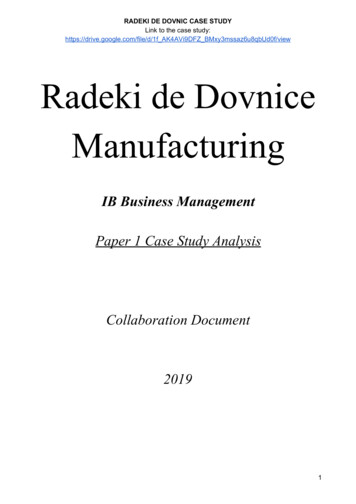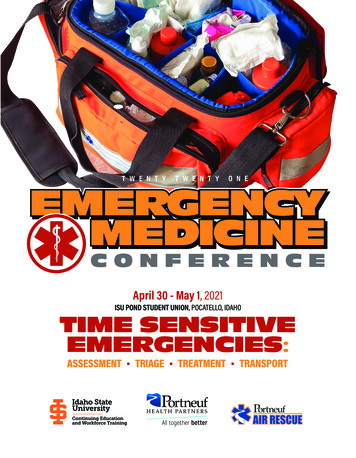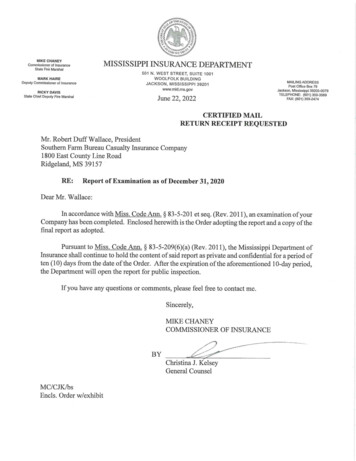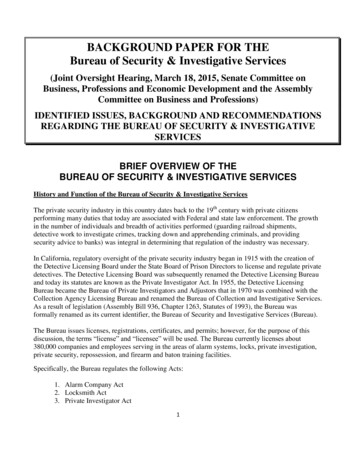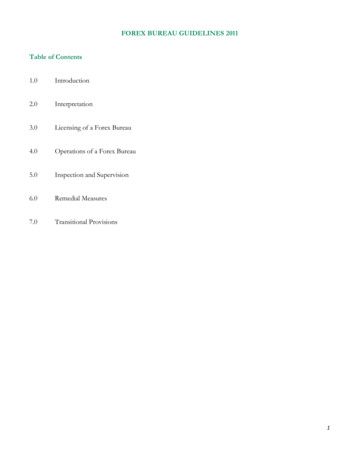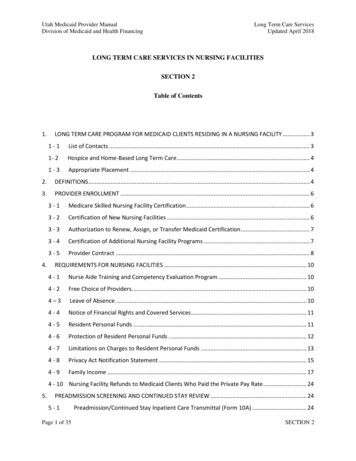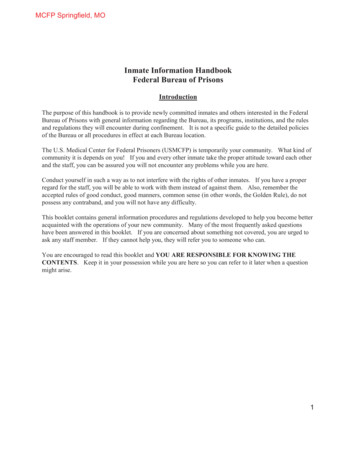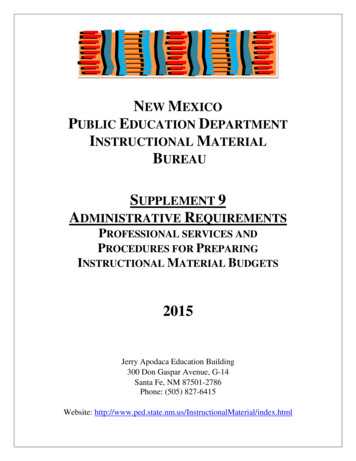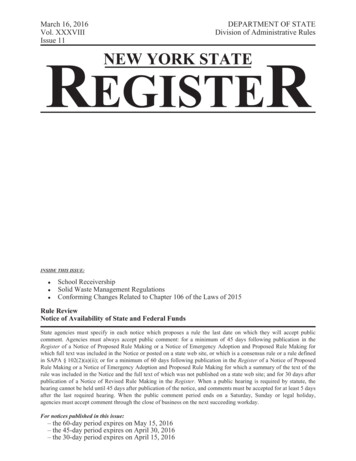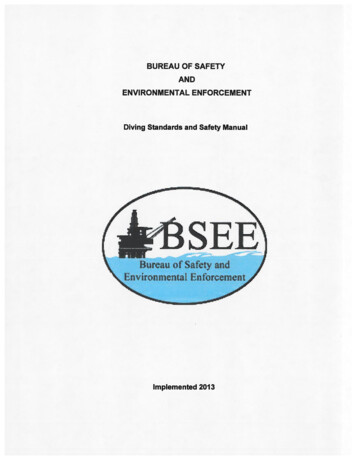
Transcription
TABLE OF ------ 11.11.22.Active Diver Certification RequirementsMaintaining CertificationCertification LapseSuspension and Revocation of Dive Certifications12141515GeneralPre-Dive ProceduresDiving Procedures and RequirementsPost-Dive ProceduresSCUBA Diving ModeDrysuit DivingDiving in Low VisibilityOverhead Obstruction DivingCold-Water DivingOffshore Platform DivingDiving Near Known Unexploded OrdinanceContaminated Water Diving171921222324242425252626General PolicySupport EquipmentOpen-Circuit SCUBA Diving Equipment272727MEDICAL ----------------------- 306.16.26.36.47.44567891010DIVING --------------------------- 275.15.25.36.Deputy Director, Bureau of Safety and Environmental EnforcementDiving Program ManagerDiving Control and Safety BoardDiving Safety OfficerRegional Diving OfficerLead DiverActive DiversObserver Divers [To Be Developed *]Diver ReciprocityDIVING STANDARDS AND PROCEDURES-------------------------------------- E DIVER CERTIFICATION AND TRAINING------------------------------ 123.13.23.33.44.Program Mission; Goals, Core Products, and Services; and ManagementGeneral ProvisionsPOSITIONS AND ----------- 42.12.22.32.42.52.62.72.82.93.Page No.Medical ExaminationsReporting Changes in Medical ConditionLapsed Dive PhysicalsFunding for BSEE Diving Physical Examinations30303031NITROX ------------------------------- 327.17.27.3GeneralRequirements for Authorization to Use NitroxDive Personnel Requirementsiii323232
7.48.Nitrox Diving Equipment32STAGED DECOMPRESSION SCUBA DIVING----------------------------------- 33To Be Developed *9.MIXED GAS ------------------------- 34To Be Developed *10. ------------------------------------ 35To Be Developed *11. EMERGENCY ---------------- 3611.1 Dive Accident Management11.2 Emergency Protocols363612. RECORD KEEPING AND REPORTING REQUIREMENTS------------------- 3812.1 Recordkeeping12.2 Reporting Diving IncidentsAPPENDICESAppendix 1:Appendix 2:Appendix 3:Appendix 4:Appendix 5:Appendix 6:Appendix 7:Appendix 8:Appendix 9:Appendix 10:Appendix 11:3838List of AcronymsDefinitionsBSEE Confined Water Diver EvaluationBSEE Open Water Diver EvaluationBSEE Dive PlanBSEE Dive Plan – Additional Diver Continuation PageEmergency Management PlanBSEE Field Neurological ExamBSEE Diving Incident Report FormSample Trip ReportBSEE Dive Log1-12-13-14-15-16-17-18-19-110-111-1* Diving activities that are in Chapters or Sections designated “To Be Developed” areprohibited until developed and approved by the DCSB.iv
BSEE Diving Standards and Safety ManualSECTION 1: OVERVIEW1.1Program Mission; Goals, Core Products, and Services; and Management1.1.1Program Mission. The mission of the Bureau of Safety and EnvironmentalEnforcement’s (BSEE) Diving Program is to provide, train, and equip its divers toperform a variety of underwater tasks in support of the agency’s scientific,investigative, and compliance monitoring programs and to ensure that all dives areconducted safely and efficiently.1.1.2Goals, Core Products and Services of the BSEE Diving Program.A. Establish standards and implement policies and procedures for conducting safeBSEE Diving operations.B. Train and certify scientists and scientists in training in a variety of diving relatedsubjects.C. Provide BSEE Active Divers with safe, state-of-the-art, and well maintained diveequipment.D. Investigate and implement new diving technologies and techniques for BSEEDiving operations.E. Provide BSEE Active Divers to support field operations, as needed.F. Promote, facilitate, and implement coordination and communication betweenprivate sector, academic and government diving entities.1.1.3Management.A. The BSEE, Deputy Director has overall administrative responsibility for the BSEEDiving Program.B. Management of the diving program is delegated from the Deputy Director to theChief, Environmental Enforcement Division as the BSEE Diving ProgramManager in consultation with the BSEE Diving Control and Safety Board (DCSB)and Diving Safety Officer (DSO).C. The DCSB reviews and establishes diving regulations, policies, and proceduresdeemed necessary to ensure a safe and efficient diving program.D. The DSO reports to the Deputy Director and is responsible for operationaloversight of the BSEE Diving Program.E. As required by 29 CFR 1910, Subpart T, the DCSB has absolute andautonomous authority over diving operations.1.2General Provisions1.2.1Purpose. Promoting science based compliance.A. BSEE Diving is scientific diving. “SCIENTIAE CEDIT MARE” is Latin for “TheSea Yields Knowledge.” Our purpose is to gather that knowledge, using thediving and safety standards set by this manual, and use it to verify compliancewith various mitigation measures, conditions of approval, etc. and assess thescience that established it.B. The purpose of the BSEE Diving Standards and Safety Manual (Manual) is toensure all BSEE diving is conducted in a manner that will maximize protection ofits divers from accidental injury and/or illness, and to set forth standards fortraining and certification that will allow reciprocity with other science-orienteddiving programs. Fulfillment of these purposes shall be consistent with thefurtherance of science based compliance, research and safety.C. This Manual sets minimum standards for BSEE diving operations, describes theorganization for the conduct of scientific diving, and the basic standards andprocedures for safety in scientific diving operations. It also establishes a1
BSEE Diving Standards and Safety Manualframework for reciprocity between BSEE and other organizations that adhere tothese standards.D. This manual is not intended to be a comprehensive discussion of diving physics,physiology, medical symptoms, diving equipment, dangerous marine life, etc.1.2.2Definition of Scientist and Scientist-In-Training. For the purposes of performingoperational scientific dives, or scientific training and proficiency dives consistent withthis Manual, divers must be one of the following:A. Scientist. An individual who utilizes scientific expertise to perform BSEE diveswithout direct or indirect supervision or guidance from a more qualified individualas determined by the on-site Lead Diver (LD).B. Scientist-In-Training. An individual who utilizes scientific expertise to performBSEE dives under the direct or indirect supervision or guidance of a scientistand/or with approval of the on-site LD.1.2.3OSHA Scientific Exemption.A. In 1982, The Occupational Safety and Health Administration (OSHA) exemptedscientific diving from commercial diving regulations (Code of Federal Regulations,29 CFR 1910, Subpart T) under certain conditions that are outlined below. Thefinal guidelines for the exemption became effective in 1985 (Federal Register,Vol. 50, No.6, p.1046).B. Per 29 CFR 1910, Subpart T, “Scientific diving means diving performed solely asa necessary part of a scientific, research, or educational activity by employeeswhose sole purpose for diving is to perform scientific research tasks.”C. Examples of scientific diving tasks include but are not limited to: data collection(water or bottom samples flora and fauna, etc.); observing, collecting anddocumenting for research, compliance, and/or investigatory purposes * (includingthe use of cameras, evidence/information collection, etc.); and measuring andcounting. If tools are used, they include but are not limited to “light” hand tools(e.g., small hammers, pliers, screw drivers, chisels). Other ancillary equipmentsuch as small lift bags ( 100 pounds lifting capacity) and small air lifts can alsobe used if the tasks are associated with data/information collection. Tasks suchas those described above performed by BSEE divers are exempt from the OSHAcommercial diving regulations found in 29 CFR 1910, Subpart T.D. Tasks, such as those involving ship husbandry (cleaning hulls, sea strainers,replacing zincs, un-fouling a ship’s propeller); use of heavy power tools poweredby pneumatics or hydraulics from the surface; lifting, positioning and retrievingheavy objects; construction, underwater cutting or welding using exothermiccutting lances, and use of explosives cannot be conducted under the scientificexemption and as such are not considered scientific diving tasks and are notcovered by this Manual.* Scientific diving for investigatory purposes (included in Section 1.2.3.C. above)must be conducted by scientists or scientists-in-training and include verifying thatregulations, mitigation measures and conditions of approval on various leases,plans, and permits are being conducted and scientifically assessing theireffectiveness or the potential environmental consequences of non-compliance.1.2.4Scope and Application.A. The policies and procedures in this Manual apply to:1) All BSEE diving operations regardless of where or when they are conducted;2) All BSEE employees engaged in BSEE diving activities during official dutyhours (i.e., when receiving financial compensation for work performed) wherecompressed gas is breathed in a hyperbaric environment; and2
BSEE Diving Standards and Safety Manual3) Non-BSEE personnel performing BSEE dives under the direct supervision ofa BSEE Lead Diver (defined in Section 2.). For the purposes of this Manual,BSEE employees and non-BSEE personnel diving under the auspices ofBSEE shall be collectively referred to as “BSEE divers.”B. Contracted diving services are to be conducted in accordance with applicablelocal, State and Federal regulations.1.2.5Obligations, Restrictions, and Conditions.A. The BSEE Diving Program ensures all BSEE divers are in compliance with:1) All standards of general applicability outlined in 29 CFR Part 1910, Subpart T;and2) All policies and procedures outlined in this Manual.B. The BSEE Diving Control and Safety Board (DCSB) may elect to implement andenforce more stringent diving standards and procedures than those stated herein.Such changes will be promulgated in writing to all affected employees andsupervisors prior to implementation and will be included in the next revision to thisManual.C. Failure to comply with the standards outlined in this Manual may be cause for therevocation or restriction of the diver’s certification by action of the DCSB.D. No person shall engage in diving operations under the auspices of the BSEEDiving Program unless they hold a current certification issued pursuant to theprovisions of this Manual.E. No BSEE divers shall be exposed to hyperbaric conditions against their will,except when necessary to prevent or treat a pressure-related injury.F. No BSEE divers shall be permitted to dive with any known medical condition thatis likely to adversely affect the safety and health of the diver or other divers.1.2.6Substitutions for Required Equipment, Materials, Apparatuses, Arrangements,Procedures, or Tests.A. The DCSB may accept substitutes for equipment, materials, apparatuses,arrangements, procedures, or tests required in this Manual if it can bedemonstrated the substitutes provide an equivalent or increased level of safety.B. Where it is shown to the satisfaction of the DCSB that the use of any particularequipment, material, apparatus, arrangement, procedure, or test is unreasonableor impracticable, the DCSB may permit the use of alternate equipment, material,apparatus, arrangement, procedure, or test to such an extent and upon suchcondition that ensures, to the satisfaction of the DCSB, a degree of safetyconsistent with the minimum standards set forth in this Manual.C. Such changes will be codified in future revisions of this Manual and disseminatedto all BSEE divers with an effective date of implementation.1.2.7Deviations in Emergencies.A. BSEE divers may deviate from the requirements of this Manual provided that:1) The deviation is necessary to prevent or minimize a situation which is likely tocause death, serious physical harm, total loss of property, or majorenvironmental damage; and2) The LD notifies the Diving Program Manager of the deviation within 24 hoursof the onset of the emergency situation.B. The Diving Program Manager will in turn notify the Deputy Director, within 48hours of the onset of the emergency situation indicating the nature of theemergency and extent of the deviation from the prescribed regulations.1.2.8Reference Material. A copy of this Manual shall be made available to each BSEEdiver.3
BSEE Diving Standards and Safety ManualSECTION 2: POSITIONS AND RESPONSIBILITIESDuties and responsibilities delegated herein to specific roles and positions may notbe further re-delegated unless specifically authorized in this Manual.2.1Deputy Director2.1.1General.A. The Deputy Director broadly administers BSEE’s Diving Program.B. Responsibility for the day-to-day management of the BSEE Diving Program hasbeen delegated to the Chief, Environmental Enforcement Division (EED) as theDiving Program Manager.2.1.2Responsibilities.A. Overall responsibility for the BSEE Diving Program.B. Reviews appeals from BSEE divers terminated from diving by the DCSB.C. Reviews issues raised by members of the DCSB with dissenting opinions.D. Reviews minutes from DCSB meetings and provides guidance on issues raisedby the Board.E. Makes final selection for BSEE Diving Safety Officer (DSO) position.2.2Diving Program Manager2.2.1General.A. The Chief, EED is the Diving Program Manager. If the Chief, EED is not qualifiedas specified in Section 2.2.3 below to be the Diving Program Manager, then theposition shall be delegated to the DSO until the Chief, EED is qualified or anothermore appropriate senior manager is designated.B. Administers and manages the BSEE Diving Program.C. Serves as Chairperson of the DCSB.2.2.2Responsibilities.A. Responsible to the Deputy Director for the management of the BSEE DivingProgram;B. Acquires necessary budgetary resources to maintain the BSEE Diving Program.C. Implements all policies and decisions prescribed by the DCSB.D. Suspends diving operations considered to be unsafe or unwise.E. Provides a recommendation for selection of the DSO position to the DeputyDirector.F. Appoints Regional Diving Officers (RDOs) as needed.G. In consultation with the DCSB, authorizes the scope and degree of divingoperations for BSEE.H. In consultation with the DSO, recommends BSEE dive training priorities to theDCSB.I. Reviews recommendations from the DSO and takes appropriate action.J. Upon verification by the DSO, determines completion of certification requirementsand issues BSEE diver certifications and authorizations to dive.K. Signs all “Active Diver Designation Letters” and “Letters of Reciprocity” (LOR)with other organizations.L. Suspends or revokes diving privileges for violating the standards and proceduresin this Manual as directed by the DCSB.M. Monitors and enforces compliance with the applicable federal regulations and thisManual.N. If the below qualifications are not met, these responsibilities may be temporarilydelegated to the DSO.4
BSEE Diving Standards and Safety Manual2.2.3Qualifications.A. Holds a nationally or internationally recognized advanced SCUBA divingcertification.B. Has a minimum of 5 years of experience in a diving.C. Has broad technical and/or scientific expertise in research related diving (e.g.,safety, regulations, equipment, procedures).2.3Diving Control and Safety Board2.3.1General.A. The voting members and minimum composition of the DCSB shall be the DivingProgram Manager, Diving Safety Officer, Regional Diving Officers, BSEE Safetyand Occupational Health Manager, and other members as needed.B. Although the DCSB reports to the Deputy Director, per 29 CFR 1910, Subpart T,the DCSB exercises autonomous and absolute authority over operations of theBSEE Diving Program.C. The DCSB shall convene annually or more often when necessary.D. The DCSB may consult individual advisors or advisory panels with subject matterexpertise to provide additional information.E. The DCSB will consist of a majority of BSEE Active Divers.2.3.2Decision Making Process.A. The Chairperson shall strive for consensus on all DCSB issues and decisions,and every attempt shall be made to query each voting member of the DCSB onall decisions.B. A quorum of two-thirds of the voting members must be present, in person orelectronically, to conduct official business.C. Decisions will be made by majority vote with the Chairperson casting the decidingvote in case of a tie.D. Major objections to majority votes shall be made a part of the meeting minutes.Any voting member of the DCSB may request that an item be raised to theDeputy Director via written communication from the Chairperson.2.3.3Responsibilities.A. General.1) Exercises autonomous and absolute authority over and promotes the safeand effective operations of the BSEE Diving Program;2) Establishes such processes and program structure as necessary to ensurecompliance with the OSHA science exemption and effectively approve andmonitor diving projects across BSEE;3) Reviews and approves all BSEE diving operations involving equipment otherthan open-circuit SCUBA, breathing mixtures other than air or Nitrox, depthsgreater than 130 fsw or bottom times beyond the U.S. Navy nodecompression limits; and4) Delegates authority to the DSO to review and approve routine BSEE divingoperations.B. Safety.1) Ensures appropriate oversight of safety within the BSEE Diving Program;2) Advises the Deputy Director of circumstances adversely impacting safetyand/or efficiency of the BSEE Diving Program; and3) Instructs and reminds divers, LDs, RDOs to adhere to all BSEE DivingProgram regulations, standards, policies, and procedures.5
BSEE Diving Standards and Safety ManualC. Incident Review and Action.1) With the exception of incidents that reach the severity necessary to require aSerious Accident Investigation (SAI) as defined in 485 DM 7 (see Chapter 12for more details), serves as a board of review for inquiries into the nature andcause of diving incidents (including near-misses) as well as violations ofBSEE or other applicable policies and standards, and reports the results tothe Deputy Director;2) Institutes appropriate measures to mitigate the reoccurrence of dive incidents;and3) Prescribes action for unsafe or noncompliant practices or actions.D. Manuals and Procedures.1) Develops and promulgates diving and safety standards, and reviews andrevises them as necessary;2) Monitors compliance with diving and safety standards and reports noncompliance to the Diving Program Manager for action; and3) Reviews and makes changes in diving regulations, standards, policies, andoperational procedures.E. Training and Certification.1) Establishes and/or approves training and certification programs for BSEEdivers and non-BSEE divers participating in BSEE-sponsored dive projects;2) Reviews, adopts, and enforces physical conditioning and medical standardsrequired to promote diver safety;3) Recommends to the Diving Program Manager the revocation of divingcertifications;4) Determines equivalency of applicant entities with that of the BSEE DivingProgram for diving reciprocity; and5) Considers appeals from divers whose dive certifications are suspended.F. Standardized Equipment Program.1) Considers, reviews, and makes appropriate changes in diving equipmentrequirements; and2) Reviews and approves new diving technologies and techniques for possibleimplementation.2.4Diving Safety Officer2.4.1General.A. The DSO is selected by the Deputy Director upon recommendation from theDiving Program Manager.B. Reports to the Deputy Director.C. May also concurrently serve as a Regional Diving Officer when appropriate.D. Voting member of the DCSB.2.4.2Responsibilities.A. Shall suspend diving operations considered to be unsafe or unwise and reportsthis action to the DCSB.B. Provides advice to the DCSB, BSEE managers, and divers for scientific divingsafety and health related issues.C. Coordinates meetings and agendas and minutes of the DCSB.D. Conducts an annual review of all BSEE diving operations to include equipmentand personnel statuses, and any diving program recommendations or actionstaken by the DCSB to improve the safety and effectiveness of the BSEE DivingProgram and submits a report to Deputy Director via the DCSB. (Due prior toconclusion of the 1st quarter of every fiscal year).6
BSEE Diving Standards and Safety ManualE. Submits annual national diving operations plan to the DCSB for approval prior tothe conclusion of the 3rd quarter of every fiscal year.F. Approves all BSEE dive plans and proposed diving operations. May delegatethis to the RDO when applicable.G. Notifies the DCSB and applicable Regional Director as soon as possible of anydiving related incident where established practices or procedures were notfollowed, diving accident, or related medical issues.H. Submits timely reports of all diving accidents and/or related medical issuesoccurring as a result of BSEE diving operations.I. May designate a qualified diver to act in temporary capacity in absence of theDSO.J. Oversees investigations of any diving related incident unless it reaches theseverity necessary to require a Serious Accident Investigation (SAI) as defined in485 DM 7 (see Chapter 12 for more details).K. Reviews, informs, and makes recommendations to the DCSB regarding all BSEEdiving accidents, and other diving accidents of significance as well as potentialhazards, and safety measures.L. Instructs and reminds divers, LDs, and RDOs to adhere to all BSEE DivingProgram regulations, standards, policies, and procedures.M. Investigates and reviews new diving technologies and techniques.N. Signs LORs for individual scientific divers.O. Assesses appropriateness and consistency of diving safety requirements forBSEE divers and provides recommendations to appropriate BSEE dive managersand the DCSB.2.4.3May delegate the following DSO responsibilities to RDOs, when appointed:A. Ensures annual safety inspections, calibrations, maintenance, and repairs (asnecessary) of all BSEE diving equipment are conducted and records of such aremaintained.B. Ensures annual and initial evaluations/authorizations of all BSEE divers areconducted and records of such are maintained.C. Maintains a file on each diver containing diver certifications, training records,diver qualifications, medical clearance, and BSEE diver authorizations.D. Maintains master log of all diving operations.2.4.4Qualifications.A. BSEE Active Diver with a nationally or internationally recognized Diving Instructorcertification;B. Has a minimum of 5 years of experience in diving;C. Has a minimum of 150 logged dives under a wide range of conditions and levelsof difficulty;D. Has broad technical and/or scientific expertise in research related diving (e.g.,safety, regulations, equipment, procedures); andE. Currently or previously certified SCUBA instructor from a nationally orinternationally recognized certifying agency.2.5Regional Diving Officer2.5.1General.A. RDOs are appointed by the Diving Program Manager upon recommendation fromthe DSO.B. Reports to the DSO.C. Voting members of the DCSB.7
BSEE Diving Standards and Safety Manual2.5.2Responsibilities.A. Shall suspend diving operations when adverse conditions warrant and suspendsdiving activity of any diver who in the RDO’s best judgment is not physically ormentally prepared or capable of diving in the given situation.B. When delegated by the DSO, ensures annual safety inspections, calibrations,maintenance, and repairs (as necessary) of all BSEE diving equipment areconducted and records of such are maintained in their region.C. When delegated by the DSO, ensures annual and initial evaluation/authorizationof all BSEE divers are conducted and records of such are maintained in theirregion.D. When delegated by the DSO, maintains a file on each diver in their regioncontaining diver certifications, training records, diver qualifications, medicalrecords, and BSEE diver authorizations.E. When delegated by the DSO, maintains master log of all diving operations in theirregion.F. Notifies the DSO and Regional Director as soon as possible of any diving relatedincident where established practices or procedures were not followed, divingaccident, or related medical issues. Prepares and submits the required reportdetailing the incident.G. Ensures all diving activity in their region complies with procedures and safetypractices set forth in this Manual.H. Recommends to the DSO additional diver training as necessary for divers in theirregion to promote safety and maintain diving experience.2.5.3Qualifications.A. BSEE Active Diver with a nationally or internationally recognized Divemastercertification;B. Has a minimum of 3 years of experience in diving;C. Has a minimum of 100 logged dives under a wide range of conditions and levelsof difficulty; andD. Has broad technical and/or scientific expertise in research related diving (e.g.,safety, regulations, equipment, procedures).2.6Lead Diver2.6.1General.A. An LD shall be in charge of all aspects of the BSEE diving operation at the divesite and shall:1) Have the experience and training in the conduct of the assigned divingoperation;2) Have authority over execution of on-site diving operations; and3) Be at the dive location.B. LDs may dive as long as there is a qualified topside person, designated by theLD to render assistance in an emergency.2.6.2Responsibilities.A. Safety.1) Ensures all diving is planned and conducted in accordance with all prescribedBSEE diving standards, policies, and procedures listed in this Manual, as wellas all applicable OSHA standards outlined in 29 CFR 1910, Subpart T;2) Submits project-specific dive plans to the DSO for approval (see Appendix 5)prior to implementation;8
BSEE Diving Standards and Safety Manual3) Verifies the accuracy of the project-specific Emergency Management prior tothe execution of the approved project-specific dive plan (this includesverification that the designated hyperbaric chamber is operational);4) Prohibits any diver from diving who, in their opinion, exhibits problems of aphysical or psychological nature that may compromise the safety of any diver;5) Suspends diving operations when unusual hazards or environmentalconditions adversely affect the safety of the diving operation;6) Ensures emergency procedures are established and clearly understood by allpersonnel before diving begins;7) Ensures all safety and emergency equipment is in working order and at thedive site;8) Ensures all divers are monitored after each dive for signs or symptoms ofdecompression sickness or other diving-related maladies;9) Immediately reports diving-related accidents and incidents to the (RDO, ifapplicable) DSO.10) Coordinates with other known activities in the vicinity that are likely tointerfere with diving operations;11) Ensures all diver-worn equipment is properly inspected and configured inaccordance with the standards outlined in this Manual; notifies (RDO, ifapplicable) DSO of any equipment issues.12) Obtains concurrence from the vessel captain and ensures all applicablevessel checklists have been completed prior to initiating diving operationswhen applicable;13) Conducts pre- and post-dive safety briefings as well as the objectives of thedive (includes review of the emergency procedures);14) Ensures qualified individuals are assigned to fulfill all required diving andsupport positions;15) Maintains a log of all diving operations conducted during a specific project;and16) Prepares a project Trip Report within one week of returning from a diveproject (see Appendix 11).2.6.3Qualifications.A. BSEE Active Diver with a nationally or internationally recognized Divemastercertification;B. Possess the experience and training necessary to conduct the assigned divingoperation; andC. Current in CPR, including adult AED, first aid and oxygen administration, and beknowledgeable in dive accident management.2.7Active Divers2.7.1General.A. Directed to conduct underwater tasks in support of BSEE’s mission provided theyfall within the guidelines of Section 1.2.B. Must be scientists or scientists-in-training.C. Authorized to dive under the BSEE Diving Program and are sufficiently trainedand experienced to undertake assigned diving tasks safely and effectively.D. May participate with other agency diving operations as a reciprocity diver.2.7.2Responsibilities.A. Adheres to the standards contained within this Manual when conducting BSEEdives.9
BSEE Diving Standards and Safety ManualB. Refuses to dive when in their judgment, conditions are unsafe, or if they would beviolating the precepts of their training or the requirements in this Manual.C. Maintains good physical condition and a high level of diving proficiency.D. Reports to the LD any changes of a physical or psychological nature that mayadversely impact their or their buddy’s fitness to dive.E. Will not begin or continue a dive if problems exist of a physical or psychologicalnature that can compromise the safety of the diver or other divers.F. Ensures diving equipment used is maintained in a safe operating condition.G. Is accountable for BSEE-issued equipment.H. Adheres to the buddy system, actively monitors buddy status, including, but notlimited to, cylinder pressure, and intervenes to the maximum extent practicable toensure the safety of the diver.I. Refrains from the use of illegal drugs that could compromise the safety of thediver or other divers and is subject to a drug screening program.2.7.3 Qualifications. BSEE Active Divers shall meet the requirements outlined in Section 3of th
heavy objects; construction, underwater cutting or welding using exothermic cutting lances, and use of explosives cannot be conducted under the scientific exemption and as such are not considered scientific diving tasks and are not covered by this Manual. * Scientific diving for investigatory purposes (included in Section 1.2.3.C. above)

